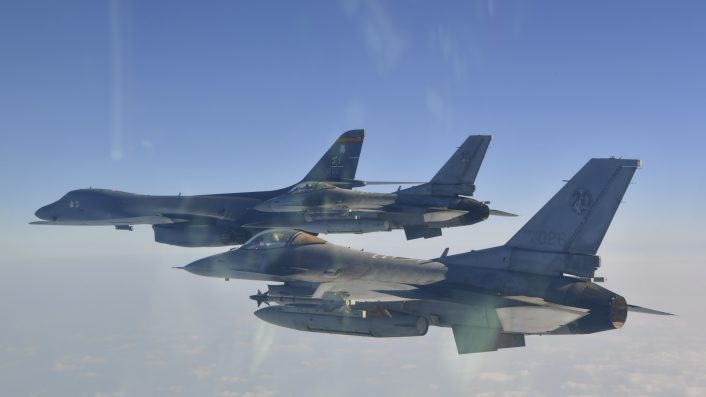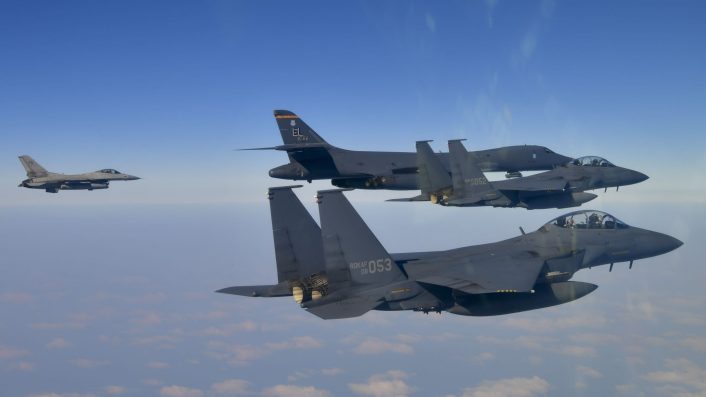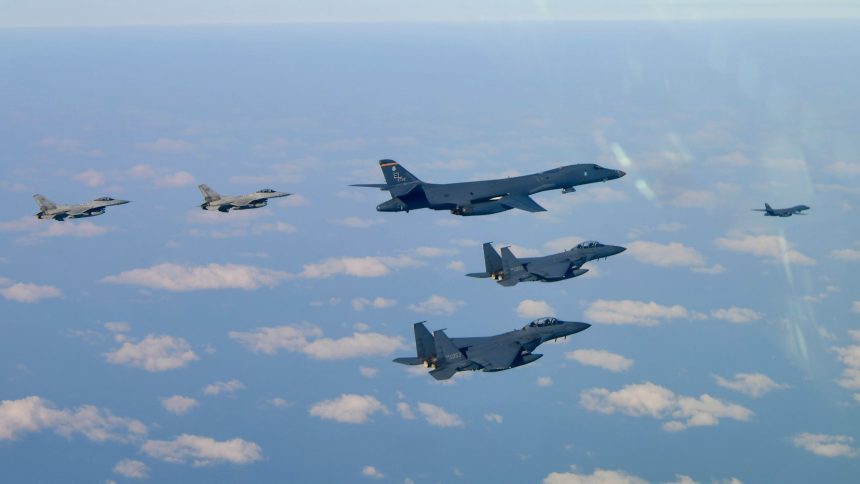The training validated the two nations’ combined ability to conduct strikes, operate together in a contested environment, and ensure the combat readiness in the Indo-Pacific theater by building proficiency in aircrew tactics, techniques, and procedures.
A massive formation of U.S. and South Korean aircraft, including U.S. Air Force B-1B Lancer bombers and F-16s, U.S. Marine Corps F-35Bs and ROKAF (Republic of Korea Air Force) F-35As and KF-16s, conducted a “bilateral simulated precision strike and air interdiction training” on Feb. 20, 2025 over South Korean airspace, according to PACAF (Pacific Air Forces). The U.S. and South Korean F-35s, however, could not be seen in any of the official images and videos from both the services.
Seoul directly attributed the drills being aimed at North Korean military threats. The PACAF said the training validated “the two nations’ combined ability to conduct strikes and operate together in a contested environment,” without mentioning North Korea.
Images released on the DVIDS network and a video by Yu Yong-won TV show the two B-1Bs – assigned to the 34th Expeditionary Bomb Squadron (34th EBS) currently deployed to Guam’s Andersen AFB (Air Force Base) as part of the BTF (Bomber Task Force) 25-1 – accompanied by three F-16s and two ROKAF F-15K Slam Eagles in a seven-aircraft formation flight.
The PACAF release and image captions on the DVIDS network said that the two B-1Bs, F-16s, four ROKAF F-35As and four U.S. Marine Corps F-35Bs then conducted the “simulated precision strike and air interdiction training.” The ROKAF F-15Ks previously “escorted the B-1Bs into the Korean theater of operations.” Two of the F-16s in the DVIDS images have however been identified as belonging to the USAF, however they bear ROKAF markings.
Lethal, ready, and stronger together. ⚔️✈️@51stFW F-16s joined USAF B-1s, 대한민국 공군 (Republic of Korea Air Force) F-15Ks & F-35As, and @USMC F-35Bs for bilateral precision strike & air interdiction training—proving our #WarriorEthos in a contested environment.@7thAF pic.twitter.com/6dqBc2l56P
— PACAF (@PACAF) February 20, 2025
Aircraft formation and composition
The PACAF release said:
“Three U.S. Air Force F-16 Fighting Falcons from the 51st FW; four ROK Air Force F-35A Lighting IIs from the 17th FW, Cheongju Air Base ROK; and four Marine F-35Bs from the 1st Marine Aircraft Wing (1st MAW), Marine Corps Air Station Iwakuni, Japan, joined the bombers for simulated precision strike and air interdiction training, validating the two nations’ combined ability to conduct strikes and operated together in a contested environment.”
The statement brings the total number of airframes involved in the drills to 13 aircraft. The officially released pictures on DVIDS and a video by Yu Yong-won TV, however, do not show the F-35s from either of the air forces but shows two ROKAF F-15K Slam Eagles with two USAF B-1Bs and three F-16s.
The caption for the lead image on DVIDS reads: “The B-1s and F-16s conducted precision strike and air interdiction training with four ROKAF F-35As, one more U.S. Air Force F-16, and four U.S. Marine Corps F-35B Lightning IIs following the formation flight.” As mentioned earlier, the PACAF’s X post and DVIDS identifies two of the F-16s as belonging to the U.S. Air Force, but their markings identify them as belonging to the ROKAF.

In the Yu Yong-won TV video, one twin-seater F-16 could be seen, which could be the F-16D Block 40 of the USAF’s 51st FW at Osan. It is also distinguished by the different paint scheme. Thus, it could mean that there were two ROKAF KF-16s and three USAF F-16s in total.
Taking into account the F-15Ks and assuming there are two KF-16s and three USAF F-16 Block 40s from the 51st FW, the total number of aircraft which participated in the exercise would increase to 15.
None of the publicity material showed a live-fire component, and all the aircraft were seen without air-to-ground weapons. This could imply that the only aircraft to employ weapons were the B-1Bs, which carry them internally.

Exercise goals
In the PACAF press release, Seventh Air Force commander Lt. Gen. David Iverson described the exercise as “advanced training” that “ensures we’re able to maintain the high levels of readiness necessary for our combined defense posture.” He further added “Each time our aircrew plan, execute and debrief together, we build proficiency in our tactics, techniques and procedures to defend the Alliance, if required.”
A machine translation of the semi-official Yu Yong-won TV’s short video feature, that often carries interviews with South Korean military personnel and senior service and formation commanders, called it the “first […] ROK-US Joint Air Training with US Strategic Bomber Deployment” of the year 2025. The drills displayed the United States’ “extended deterrence” and enhanced the “interoperability of ROK-US combined forces.”
US Air Force B-1B Lancer, and South Korean F-15K and KF-16 fighter jets fly over South Korea during joint air drill on Mar. 3. The Lancer is assigned to 34th Expeditionary Bomb Squadron at Ellsworth Air Force Base, South Dakota, takes off from Andersen Air Force Base, Guam. pic.twitter.com/gM3srtX0Dk
— Ryan Chan 陳家翹 (@ryankakiuchan) March 3, 2023
Beside the B-1Bs, the video identified the other aircraft as ROKAF’s F-35A, F-15K and U.S. F-16s, but did not mention the KF-16s or the F-35Bs that the PACAF mentioned. It then added that the exercise demonstrated “deterrence capability against North Korea’s increasingly sophisticated nuclear and missile threats. Based on close cooperation, ROK and the US will continue to expand joint training to deter and respond to North Korea’s threats and strengthen cooperation in the ROK-US alliance.”
Maj. Gen. Jason R. Armagost, head of the 8th Air Force, in a Feb. 19 press conference touched upon the U.S. and South Korea CNI (Conventional Nuclear Integration) initiative, and the practice of South Korean fighters escorting U.S. bombers. “[Through] habitual training and planning and exercise relationships, what we see is the ability to seamlessly integrate those operations across the spectrum of conflict,” said Armagost.
Other large formations and B-1B participations
Such massive aircraft formations have been seen in the far northeast Asian airspace before. On Nov. 3, 2024, 13 aircraft, including four ROKAF F-15Ks, four JASDF F-2s (local highly modified variant of the F-16) and two U.S. Air Force F-16s, conducted a trilateral escort of a B-1B Lancer over an unspecified region of the Indo-Pacific waters.
🇺🇸 – 🇯🇵 – 🇰🇷 fighter aircraft escort a B-1 Lancer during a trilateral escort flight Nov. 3, 2024. This exercise continues strong trilateral cooperation, enabling immediate response to regional security challenges.
Read More: https://t.co/bsjY65UcTE pic.twitter.com/m50DEosawP
— U.S. Indo-Pacific Command (@INDOPACOM) November 3, 2024
Prior to this, on Oct. 1, 2024, two U.S. B-1B Lancers “participated in a simulated combined close air support training with the two ROK F-15Ks and U.S. 607th Air Support Operations Group personnel at Pilsung Range in South Korea,” according to the INDOPACOM (Indo-Pacific Command).









